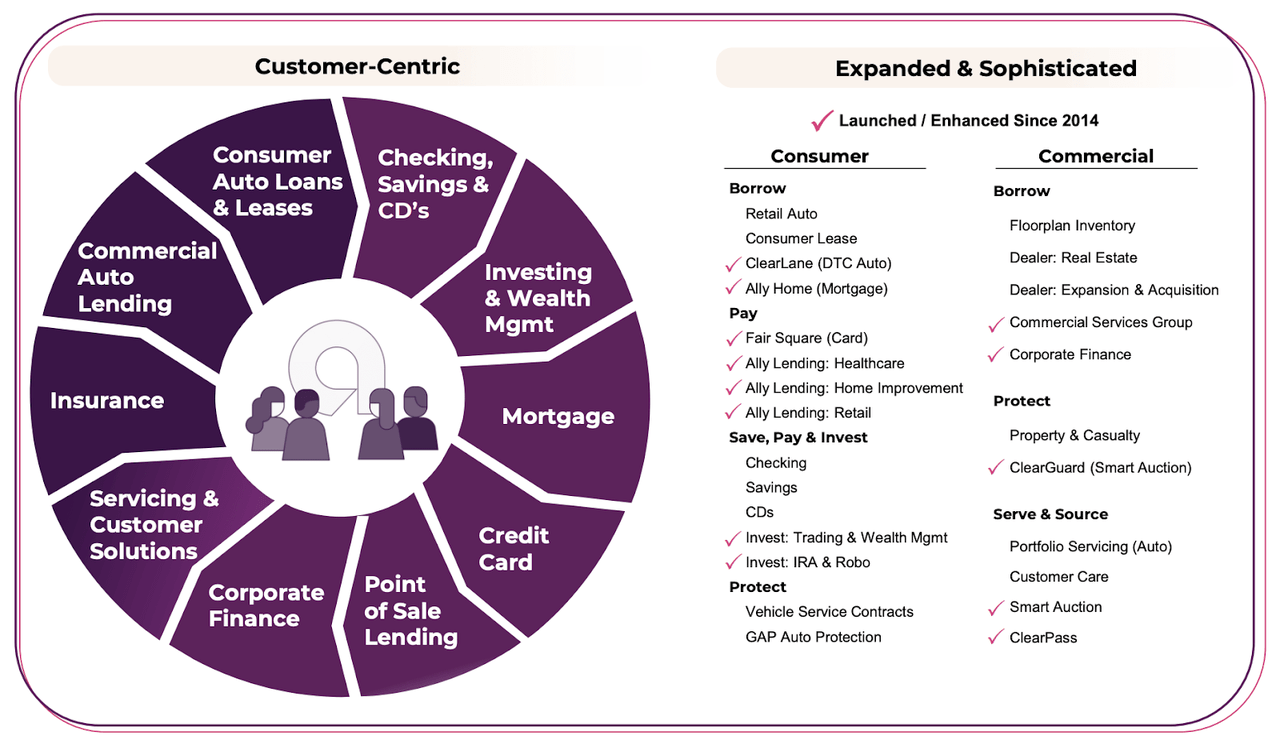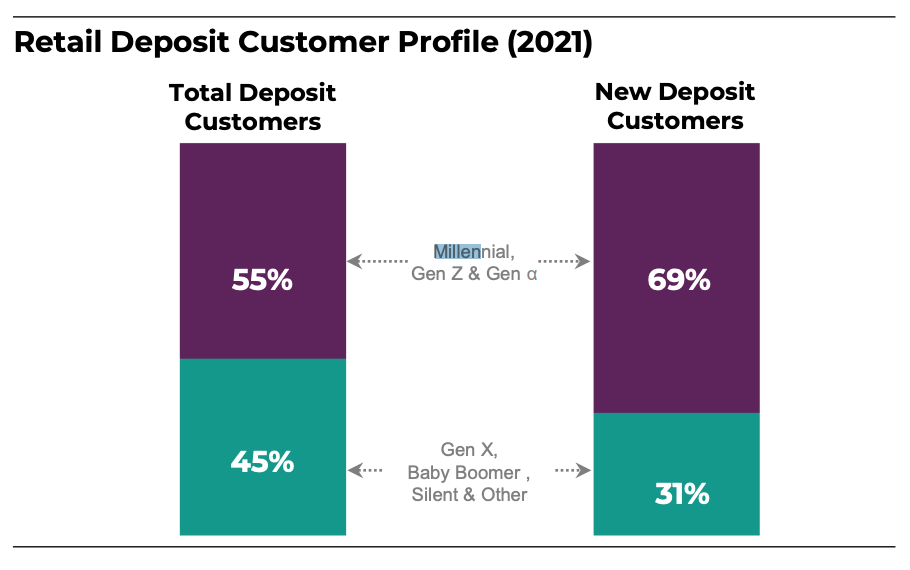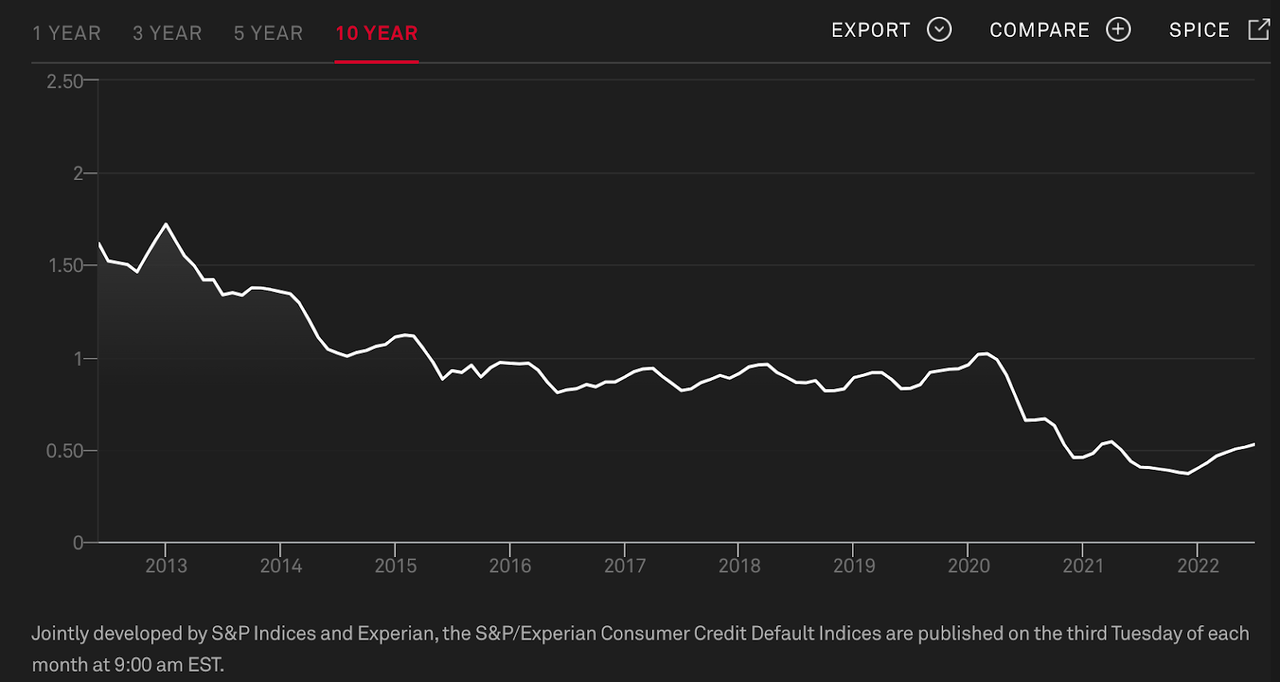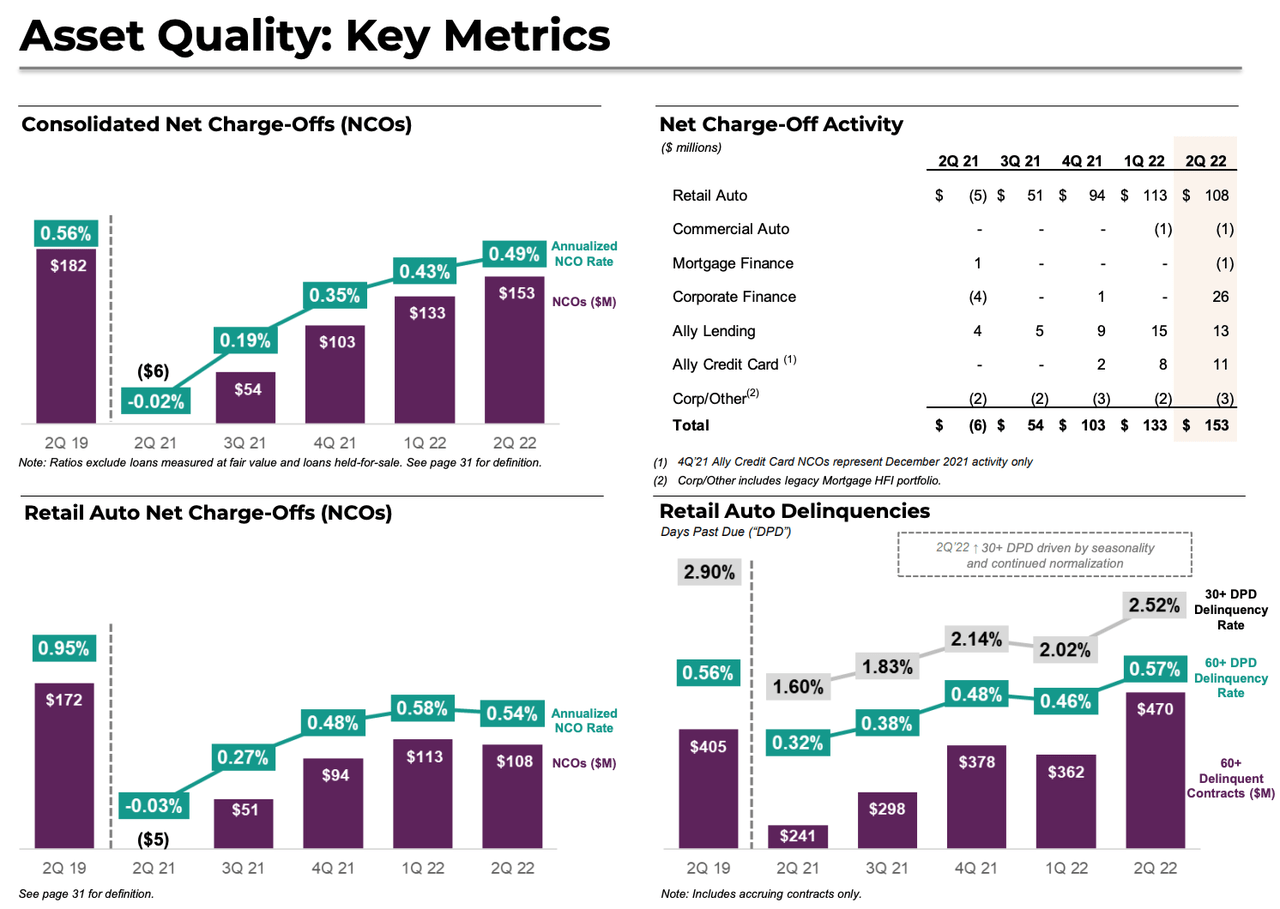
Adam Smigielski
Ally Financial (NYSE:ALLY) is over 100 years old, with its roots in the auto finance sector. The company began its life in 1919 as General Motors Acceptance Corporation (GMAC) as the captive auto lender for General Motors. Its original goal was to support sales at the auto manufacturer.
It’s an important backdrop to understanding how Ally has today become the largest auto lender in the country, providing retail auto loans and leases and dealer loans for inventory and expansion.
But the bank has spent the last few years diversifying its product portfolio across home mortgages, insurance, credit cards, and commercial loans, organically and through acquisition. Ally has also been building deposit and investment franchises.
Fig 1.

Ally expanding product portfolio (Ally 2021 earnings presentation)
And these “other” areas of the bank are growing fast.
New products are drawing new customers and creating cross-selling opportunities that broaden and strengthen the customer relationship with the bank.
Diversified credit growth leads to reduced credit risk. And Ally’s growing retail deposit franchise has decreased funding costs at the bank. This is all translating into sustainable improvements in Net Interest Margins (NIMs) and capital ratios.
But the market is ignoring this structural evolution and their long-term benefit.
Shares have come under pressure on heightened concerns around consumer credit and rising deposit costs. The sell-side has been downgrading the company refusing to see past a year or two.
This myopic view provides long-term investors with an attractive opportunity. Ally, selling at near tangible book value with a target ROTCE of 16-18% (2Q22 ROE was 23%), is a bargain. More so if the consumer remains resilient and a shallow recession plays out.
Understanding the structural moves the market is ignoring
From a near standing start, Ally has grown its broader credit portfolio by almost 6x since 2014. Figure 2 shows that auto related credit was 72% of Ally’s lending and lease portfolio in 2014, but by 2021 had shrunk to 58%.
Fig. 2

Credit portfolio diversification (Ally 2021 earnings presentation)
New customers grew 52% between 2014 and 2021 – mainly the result of these new product offerings. While margins widened from new higher yielding products such as point-of-sale financing and credit cards.
Both products have average interest rates well above the bank’s other products. In 2Q22, Ally reported that point-of-sale financing had a rate of 11.94%, while credit cards were at 19.71%. Retail auto loans, the company’s largest credit category, was just 6.82%.
This simple rate comparison of course doesn’t adjust for credit costs. But the key point is that diversification into these high yield products will drive NIMs higher.
Speaking of Net Interest Margins, liability management has also been driving improvements for Ally. In Figure 3, we can see that NIMs have expanded from 2.54% in 2014 to 3.56% by 2021. By the end of 2Q22, net interest margin was 4.06% when adjusting for core OID.
The key to the company’s success? Cheap deposits.
Fig. 3

Net Interest Margins (NIMs), Cost of funds, and Deposit profile (Ally 2021 earnings presentation)
Figure 3 shows how Ally has significantly tilted its liability profile from what was once only 41% deposit supported to 89% by 2021. This has led to the cost of funds falling to 1.2% in 2021 from 2.0% in 2014.
Ally’s all digital bank brand, I suspect, will also create enduring advantages against other banks that investors should pay attention to.
As Figure 4 demonstrates, marketing efforts have been attracting a younger, millennial customer who is more comfortable banking online.
Fig. 4

Evolving retail deposit profile (Ally 2021 earnings presentation)
Ally is also able to deliver efficiency ratios that outperform other banks. In 2021, Ally reported an adjusted efficiency ratio of 43.7% (excludes insurance ops), well below the average of its last three years of 48.4%.
In comparison, money center banks such as Bank of America and JP Morgan averaged ratios of 63.9% and 57.3%, respectively. While banks of comparable asset size had efficiency ratios of 57%.
The cost advantages that digital only banks have allow them to offer higher deposit rates than brick and mortar ones without impacting overall profitability.
Interestingly, investors were paying up for fintechs such as Lending Club and Sofi when they launched plans to access low-cost deposits and offer all digital services. A strategy that Ally has already been executing for years now.
Solid capital returns
These structural moves have allowed Ally to release excess capital and CEO Jeffrey Brown hasn’t been shy about returning these dollars to shareholders.
In the latest CCAR exercise, Ally saw its Stress Capital Buffer (SCB) requirement lowered by 100 bps to 2.5% from 2020. A testament to the bank’s strategy that has both lowered credit risk through product and customer diversification and improved margins by utilizing stable, low-cost deposits.
These improvements have allowed management to trim its outstanding shares by 35% between 2Q22 and 2Q16, while substantially growing the dividend by over 3x.
At USD 1.2 per annum, Ally has a yield of 3.42% at its current price, above the KBW index of 2.72% and the S&P 500 of 1.69%.
Fig 5.

Ally capital returns (2Q22 earnings presentation)
Credit costs a concern but fears may be overblown
It’s difficult to know how deep of a recession we’ll have in the US with such a plethora of issues to mind: Covid, Ukraine-Russia, inflation, interest rates.
A deep recession would raise credit costs and slow asset growth at all banks.
But investors should recognize that the banking sector that is navigating these challenges is very different from the one that survived 2008.
Regulatory capital has been heightened, loan losses are recognized upfront thanks to the Current Expected Credit Loss (CECL) framework, and balance sheets have never been better. Meanwhile, employment remains robust and wages are rising – typically a benefit to consumer banks like Ally.
Credit conditions have also been normalizing from enhanced credit trends, the net result of government stimulus providing consumers with pandemic support. One graph relevant to Ally’s consumer exposure is Figure 6.
The S&P/Experian Consumer Credit Default index shows that while defaults have risen to 0.53%, they are still well below the 10-year average. So we have a bit of way to go before investors should start panicking about credit costs.
Fig. 6

S&P/Experian Consumer Credit Default index (S&P/Experian)
Still, there is no doubt that charge offs at Ally have been rising, particularly in Retail Auto as Figure 7 shows. The bank saw USD 153m worth of loans written off from its reserves in 2Q22. This is up from a USD 5m reserve release in the comparable period last year.
Most of the write-off was in Retail Auto loans at USD 108m. And all the company’s leading credit indicators such as 30+ Days Past Due (DPD) and 60+ DPD are on the rise.
Fig. 7

Asset quality update (2Q22 earnings presentation)
But there is reason to be confident that Ally’s mainly consumer portfolio will be resilient.
The bank’s auto credit portfolio, its largest credit product, focuses mainly on prime credit customers. For instance, the carrying value of non-prime consumer automotive loans before considering Allowances for Loan Losses (ALL) was ~11.0% of total consumer automotive loans or about USD 9bn at 2Q22.
Reserves for retail auto loan losses are now more than double what they were in the middle of 2019 when interest rates were around this level. Ally’s ALL as a percentage of its retail auto portfolio stood at 3.51% at the end of 2Q22 compared to 1.48% at the end of 2Q19. The majority of these additional reserves came from the bank adopting CECL accounting at the beginning of 2020.
And net charge-offs and 30+ DPD delinquencies are still below the comparable period in 2019, despite the ramp up in Ally’s reserves.
In sum
Ally’s shares are undervalued at near USD 35. This is just 1.10x adjusted tangible book value of USD 32.2. If you need more convincing, you can take comfort in the fact that Berkshire Hathaway recently bought Ally shares at an average price of USD 43.48: link. Then significantly increased its position to 9.7% of the bank as prices fell during the second quarter.
The key concern of course is whether the consumer will hold up to the withering attacks of inflation and higher interest rates. As costs rise to levels unseen in more than a decade, will that also deteriorate Ally’s consumer portfolio, book value, and earnings potential?
The answer is Yes – but not in the long-run.
Ally’s structural moves will create lasting benefits for shareholders. Let’s just look at the company’s “flywheel”. As a digital bank, Ally has a cost base where it can compete aggressively for deposits. It can use these low-cost funds to grow a diversified credit portfolio, one that has a lot of room for high margin growth.
Diversified bank and credit offerings attract long-term customer relationships. These relationships are signing up to new credit products with higher interest margins and asset management products that generate fee income that further diversifies and strengthens the bank’s earnings stream.
Ally is still in the early innings of this diversified growth, but the benefits are starting to show through its dividends and share repurchases. And regulators seem to agree when they lowered the bank’s SCB requirement.
Shareholders that can see beyond this cyclical trough and who understand the bank’s spinning flywheel will be rewarded in the long-term with a diversified consumer bank with attractive growth prospects, improving margins, and a strong balance sheet.


Be the first to comment